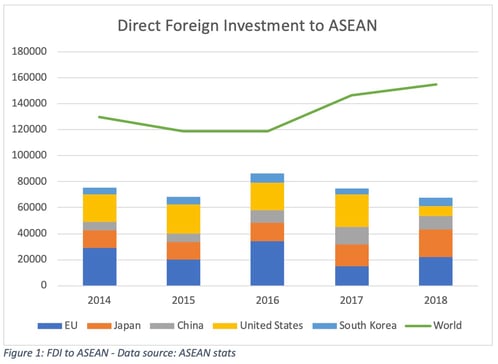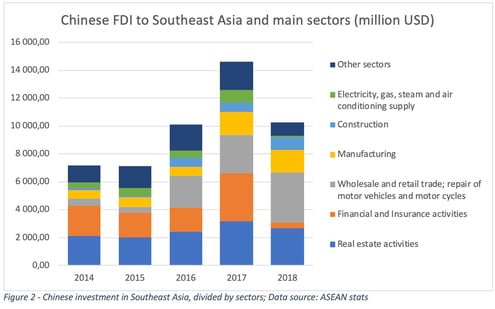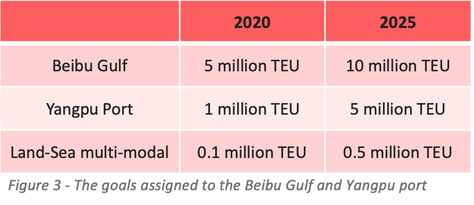
On August 15, the Chinese National Development and Reform Council (NDRC) issued its latest five-year plan regarding the new international land-sea trade corridor. This far-reaching logistics policy document organizes the development of a smooth multi-modal shipping channel between China and Southeast Asian countries. More importantly, it connects the China Railway Express with the Yangzi River economic belt (with connections to Shanghai’s Port), thereby forming a global shipping network under the Belt and Road Initiative.
The new international land-sea trade corridor is a Chinese logistics plan aiming to support and enhance trade between China and Southeast Asia. This policy plan is a new version of an earlier project: The China-Singapore connectivity project, issued in 2015. Just like many other Chinese logistics projects, this plan focuses on developing a multi-modal shipping network, an especially a railway to maritime connection. At the end of this article, you’ll find a brief list of the Chinese cities identified as potential logistics hubs in this trade corridor.
Beyond the Southeast Asian market
This corridor’s main purpose is to support Chinese exports to the Southeast Asian market by providing smooth logistics connections. More specifically, it focuses on four areas of trade: food, modern manufacturing industry, natural resources, and e-commerce.
As electronic wares and natural resources are two of the top trading goods between China and the ASEAN, China plans on expanding logistics networks between Southeast Asia and Southwestern China, including Chongqing, Guizhou, Sichuan for electronic wares, motorcycle, and automobile. And growing Chinese investments in Southeast Asian e-commerce infrastructures and networks support this trend. For instance, in 2016, Alibaba acquired Southeast Asia's largest e-commerce company, Lazada.
Building a regional supply chain of manufacturing industry
In the long term, this corridor may help China move up the value chain in the manufacturing industry. With the on-going China-U.S trade war, and increasing labor cost in China, Chinese and foreign manufacturers are now seeking to transfer labor-intensive manufacturing industries to Southeast Asia.
Currently, China is the third-largest investor in Southeast Asia, after the EU and Japan (Figure 1), with steady investment growth in the retail and manufacturing industries.

In 2018, the retail sector and manufacturing industry were the first and third largest sectors for Chinese investment in the region (Figure 2), surpassing the traditional front runners: the real estate and financial industry.

This also means that, beyond irrigating the Southeast Asian market with Chinese products, the land-sea corridor will also pave the way for China to build a strong regional supply chain for the manufacturing industry, thereby targeting a broader international market.
Land Channel: Connecting Southeast Asia with Europe
And more precisely, these developments target the European market. By making Chongqing the focal point, China can build a land-sea shipping route between Southeast Asia and Europe via China, thereby connecting this trade corridor with the China Railway Express to Europe. To support the connection, China is investing heavily in road and railway infrastructures in Southeast Asia. For example, investors built the China-Laos railway to remove shipping bottlenecks.
And beyond infrastructures, Chinese investors are working on facilitating shipping. Some areas along this trade corridor are included in the China-EU Smart and Secure Trade Lanes, a China-EU pilot project to test end-to-end supply chain security instruments and mechanisms under the WCO SAFE Framework of Standards.
Possible political risks
As a sample project of the Chinese BRI, this trade corridor plan has painted a very promising blueprint for the multi-modal shipping channel connecting Southeast Asia to China and Europe. But the economic opportunities come with a dose of political risk.
Firstly, the territorial disputes between China and Southeast Asian countries over the South China Sea can have a negative impact on economic activities. Intensified disputes may trigger countries using economic sanctions to obtain a better position in the dispute. For example, China limited the import of Filipino bananas from 2012 to 2016 due to the heated territorial disputes. Secondly, the political instability of some of China’s neighbors, such as Myanmar, can pose potential risks to the security of this shipping channel. Finally, the opaque Chinese policy-making process creates uncertainty as to how the corridor will be used in the future.
But this also creates positive externalities. China may tend to behave in a more transparent way for projects on this trade corridor, to ensure smooth economic activities, since it has been labeled as a sample project paving the way for other international cooperation projects on connectivity and logistics under the BRI initiative.
THE POTENTIAL LOGISTICS HUBS
Chinese cities and ports identified as potential logistics hubs under the New land-sea International Trade Corridor project.
> Chongqing
Located in Southwestern China, Chongqing was chosen as the logistics hub for inner China, to facilitate cross-border trade. It will be the focal point connecting the China Railway Express to Europe, and the Yangzi River economic corridor to Shanghai’s Port. Chongqing is also one of China’s 18 pilot free trade zones. Cities and areas included in the pilot free trade zones will receive policy benefits supporting foreign trade and logistics development.
> Beibu Gulf
Beibu Gulf covers the area between the North of Vietnam and Southwestern China. Located in the Guangxi province, it has recently been included into China’s 18 pilot free trade zones. Beibu Gulf is set to become the maritime shipping hub connecting China with Southeast Asia. Chinese ports located on the Beibu Gulf focus on different industries.
- Fangcheng Port: Commodity and Reefer
- Beihai Port: International Cruise, trade and logistics for eco-friendly products
- Qinzhou Port: Container shipping
> Yangpu Port
Located in the province of Hainan, it is designed to become a regional international logistics hub, focusing on transshipment of containers, with potential maritime shipping connections to Singapore, Vietnam, Australia, New Zealand, and other international destinations.

@ Photo by Holger Link on Unsplash

Ganyi Zhang
PhD in Political Science
Our latest articles
-
3 min 08/01/2026Lire l'article
-
Subscriber France: Road transport prices remain stagnant in November
Lire l'article -
Container shipping in 2025
Lire l'article


